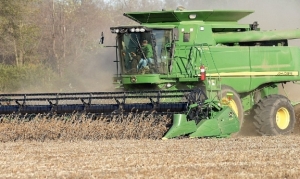Agriculture businesses add $667 million to local economy
By Steve Herring
Published in News on November 30, 2009 1:46 PM

News-Argus/BOBBY WILLIAMS
Scott Hargrove picks soybeans on the farm of Ronnie and Nelson Parks on Zion Church Road on Sunday. Wayne County farmers have been working long hours to catch up with the harvest of beans and cotton, which have been held back by a recent spate of rainy weather. More rain is forecast this week. Thousands of acres of soybeans planted each year are a mainstay of the Wayne County economy, which is heavily dependent on agriculture.
The Wayne County Cooperative Extension Service's "We Dig It" campaign asks "Did You Know?"
* Agribusiness is the No. 1 industry in the state, contributing $70.1 billion to the state's economy
* Farming and agribusiness represent 22 percent of Wayne's total gross income, representing $667 million
* Farming and agribusiness account for 20 percent of the county's employment, representing 11,503 jobs
* Wayne County has 175,265 acres of farmland -- 48 percent of the acres in the county
* There are 732 farms in Wayne County.
"The drop in the number of farms has created a tremendous disconnect for the importance of agriculture and farming as it has to do with people and society," Extension Service Director Howard Scott said.
"We think it is pretty important for people to understand that when we talk about agribusiness we are talking about the agriculture and food industry. We are talking about the natural fiber industry. We are talking about forestry.
"So we when we talk about agribusiness we are not just talking about farming we are talking about Mt. Olive Pickle Co. We are talking about Franklin Baking."
Scott pointed out that the gross farm income in the county has from grown from $148 million in 1980 to $388 million in 2008. However, farm acreage has fallen from 290,887 in 1950 to 175,265 in 2007, while during the same period the number of farms in the county dropped from 4,915 to 732.
Nationwide, 93 percent of the U.S. population lived on farms in 1790. Today that number is less than 1.5 percent. Also in 1790, farmers just hoped to be able to feed their families, Scott said. Today, one farmer feeds 144 people.
While a growing urban area, Wayne County is the third-largest agricultural county in the state, just behind neighboring Sampson and Duplin counties.
Farm Futures magazine in 2005 named Wayne County as the fifth-best place to farm out of more than 3,000 counties nationwide, Scott noted. Also, 21 of the top 100 farming counties in nation are in North Carolina.
"Our food here in the United States is very inexpensive when compared to other countries around the world," he said. "This also gives a highlight that the American farmer is very efficient in what we are doing."
Americans spend 9.5 percent of their disposable income on food compared to 18 percent in France, 26 percent in Japan and 33 percent in Mexico.
"If we start importing our foods from other countries do we really want to count on them to control our food supply?" Scott asked. "Do we really want the other counties also to control what we pay for our food?"
But competition for land between urban growth and farm is expected to be a continuing trend, Scott said, with many farming operations becoming larger, more diverse and efficient farming operations, while other small, specialty farms also develop to fill niche markets.
